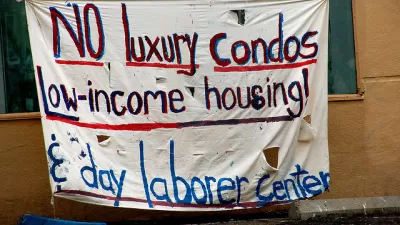What a difference a year makes! In 2011, 269 new housing units were added while over 4,220 new housing units are now under construction. Gabriel Metcalf, executive director of the San Francisco Planning + Urban Research Association (SPUR), explains.
Emily Badger notes that "San Francisco has long had a reputation as an anti-growth town" and that the San Francisco Business Times dubbed 2011 “The year of (almost) no new housing.”
She asked Gabriel Metcalf to explain the recent boom in housing contruction, as SPUR has documented it in a new analysis.
“Developers started telling me we’re in the biggest boom of our lifetime at the beginning of 2012,” says Metcalf. "But I didn’t believe them or see it until the summer."
One of the numerous reasons that Metcalf offers to explain the boom is a surprising one, considering that "anti-growth" reputation associated with the city since a 1986 ballot measure, well-documented in SPUR's "Proposition M and the Downtown Growth Battle".
According to Metcalf, the politics of development in San Francisco has changed "and this may be directly related to the recession."
“It became possible for city leaders to take some hard votes to approve projects because the voters wanted growth," Metcalf says. "The voters could not take prosperity for granted.”
The residential construction of more than 4,220 new housing units, according to SPUR, is in addition to commercial construction - which has been more consistent as many Silicon Valley area companies have chosen to relocate to The City.
"SPUR's analysis suggests the city could be on pace for unprecedented construction in the coming years, following a particularly deep low that new housing construction in the city has typically followed spikes in new permitting activity by three to five years)." Metcalf's study indicates that "[a]n additional 32,120 new residential units have been approved by the Planning Department, and applications for another 6,940 units have been filed for review."
The increase in residential construction is not only good for the economy and those looking for housing in the high-priced city, but also good for the environment, the topic of a third report in a series "on residential construction trends in U.S. metropolitan regions" by the Environmental Protection Agency (see Planetizen: Infill Development Picks Up Speed Across the U.S.).
FULL STORY: What's Behind San Francisco's Sudden Building Boom?

Alabama: Trump Terminates Settlements for Black Communities Harmed By Raw Sewage
Trump deemed the landmark civil rights agreement “illegal DEI and environmental justice policy.”

Study: Maui’s Plan to Convert Vacation Rentals to Long-Term Housing Could Cause Nearly $1 Billion Economic Loss
The plan would reduce visitor accommodation by 25% resulting in 1,900 jobs lost.

Planetizen Federal Action Tracker
A weekly monitor of how Trump’s orders and actions are impacting planners and planning in America.

Wind Energy on the Rise Despite Federal Policy Reversal
The Trump administration is revoking federal support for renewable energy, but demand for new projects continues unabated.

Passengers Flock to Caltrain After Electrification
The new electric trains are running faster and more reliably, leading to strong ridership growth on the Bay Area rail system.

Texas Churches Rally Behind ‘Yes in God’s Back Yard’ Legislation
Religious leaders want the state to reduce zoning regulations to streamline leasing church-owned land to housing developers.
Urban Design for Planners 1: Software Tools
This six-course series explores essential urban design concepts using open source software and equips planners with the tools they need to participate fully in the urban design process.
Planning for Universal Design
Learn the tools for implementing Universal Design in planning regulations.
Caltrans
Smith Gee Studio
Institute for Housing and Urban Development Studies (IHS)
City of Grandview
Harvard GSD Executive Education
Toledo-Lucas County Plan Commissions
Salt Lake City
NYU Wagner Graduate School of Public Service



























